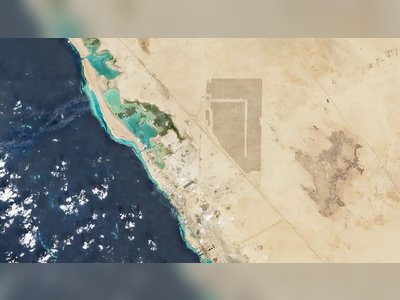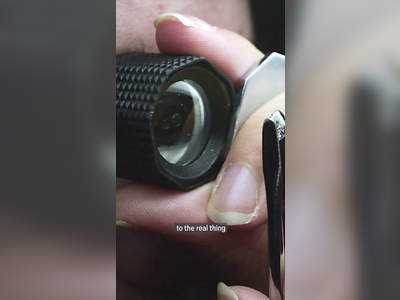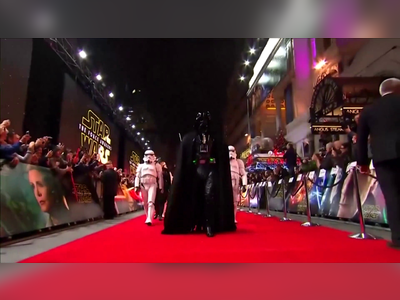
Total Solar Eclipse of 2024: Millions Witness Awe-Inspiring Celestial Event, From Mazatlan to Montreal
On Monday, a solar eclipse captured the attention of tens of millions of people in North America.
The moon's shadow passed through Mexico, the US, and Canada, causing total darkness in some areas.
Festivals, viewing parties, and mass weddings took place in the "path of totality," where the Sun's corona was visible behind the Moon.
Witnesses described the experience as breathtaking and spectacular.
The eclipse began in Mexico at 11:07 am local time and ended over Canada's Atlantic coast less than an hour and a half later.
On April 8, 2024, a partial solar eclipse occurred with the Washington Monument in silhouette.
Thousands of miles away in Montreal, Canada, people gathered to witness the event, taking pictures with their eclipse glasses.
The path of totality was 115 miles wide and home to over 32 million Americans, with an additional 150 million living nearby.
NASA ran a live webcast throughout the event.
People were excited and described their hearts racing during the experience.
During the upcoming total solar eclipse on April 8, 2024, in various states like Texas, Arkansas, Ohio, and Maine, hotels and short-term rentals were fully booked months in advance.
Eclipse watchers from around the world gathered at locations such as Ingram, Texas' Stonehenge II park and Wapakoneta, Ohio's Neil Armstrong Air and Space Museum, despite overcast conditions.
A couple, Jeni Lyn Hunter and Charles Guillory, from Floresville, Texas, identified as "pagans" and attended the event wearing Merlin hats.
In Russellville, Arkansas, over 300 couples reportedly got married at a mass wedding ceremony named "A Total Eclipse of the Heart." Delta Airlines arranged two special flights for viewing the solar eclipse on April 8, 2024, as many schools closed in the affected area.
In 2017, former President Donald Trump disregarded safety advice and looked directly at the eclipse while in the White House.
Current President Joe Biden poked fun at his rival through a social media post, while health experts advised using certified eclipse glasses to prevent retinal injury.
Only those within the totality path could safely remove their eye protection during the brief period when the eclipse was visible, which won't occur again for much of North America until 2044.
A young girl observed the total solar eclipse using a telescope during an event in Denver, Colorado.
During the 2024 solar eclipse, NASA took advantage of the sudden darkness to conduct scientific research.
They launched three sounding rockets before, during, and after the eclipse to study changes in the ionosphere, an important layer of the atmosphere for long-distance radio communication.
The eclipse also offered a rare opportunity to observe the Sun's corona, the outer layer of its atmosphere that is normally hidden by its bright surface.
NASA heliophysicist Michael Kirk described the corona as "heart-stoppingly beautiful" and "asymmetrical," as the Sun approaches the peak of its 11-year-cycle.
The eclipse provided scientists with valuable data on the Sun's impact on various systems, including satellites and power grids.
During the eclipse, the moon's rugged terrain was showcased in a "diamond ring" effect, and Venus and Jupiter were visible in the sky.
Animal behavior can be affected, with roosters crowing as if it's dawn.
Humans experience feelings of wonder and a sense of our small place in the cosmos.
After the shared experience, people exhibit more prosocial behaviors towards each other.
Festivals, viewing parties, and mass weddings took place in the "path of totality," where the Sun's corona was visible behind the Moon.
Witnesses described the experience as breathtaking and spectacular.
The eclipse began in Mexico at 11:07 am local time and ended over Canada's Atlantic coast less than an hour and a half later.
On April 8, 2024, a partial solar eclipse occurred with the Washington Monument in silhouette.
Thousands of miles away in Montreal, Canada, people gathered to witness the event, taking pictures with their eclipse glasses.
The path of totality was 115 miles wide and home to over 32 million Americans, with an additional 150 million living nearby.
NASA ran a live webcast throughout the event.
People were excited and described their hearts racing during the experience.
During the upcoming total solar eclipse on April 8, 2024, in various states like Texas, Arkansas, Ohio, and Maine, hotels and short-term rentals were fully booked months in advance.
Eclipse watchers from around the world gathered at locations such as Ingram, Texas' Stonehenge II park and Wapakoneta, Ohio's Neil Armstrong Air and Space Museum, despite overcast conditions.
A couple, Jeni Lyn Hunter and Charles Guillory, from Floresville, Texas, identified as "pagans" and attended the event wearing Merlin hats.
In Russellville, Arkansas, over 300 couples reportedly got married at a mass wedding ceremony named "A Total Eclipse of the Heart." Delta Airlines arranged two special flights for viewing the solar eclipse on April 8, 2024, as many schools closed in the affected area.
In 2017, former President Donald Trump disregarded safety advice and looked directly at the eclipse while in the White House.
Current President Joe Biden poked fun at his rival through a social media post, while health experts advised using certified eclipse glasses to prevent retinal injury.
Only those within the totality path could safely remove their eye protection during the brief period when the eclipse was visible, which won't occur again for much of North America until 2044.
A young girl observed the total solar eclipse using a telescope during an event in Denver, Colorado.
During the 2024 solar eclipse, NASA took advantage of the sudden darkness to conduct scientific research.
They launched three sounding rockets before, during, and after the eclipse to study changes in the ionosphere, an important layer of the atmosphere for long-distance radio communication.
The eclipse also offered a rare opportunity to observe the Sun's corona, the outer layer of its atmosphere that is normally hidden by its bright surface.
NASA heliophysicist Michael Kirk described the corona as "heart-stoppingly beautiful" and "asymmetrical," as the Sun approaches the peak of its 11-year-cycle.
The eclipse provided scientists with valuable data on the Sun's impact on various systems, including satellites and power grids.
During the eclipse, the moon's rugged terrain was showcased in a "diamond ring" effect, and Venus and Jupiter were visible in the sky.
Animal behavior can be affected, with roosters crowing as if it's dawn.
Humans experience feelings of wonder and a sense of our small place in the cosmos.
After the shared experience, people exhibit more prosocial behaviors towards each other.
Translation:
Translated by AI











